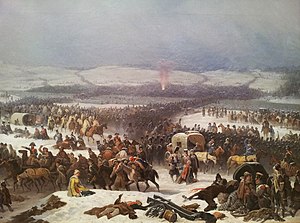Battle of Berezina
| Battle of Berezina | |||||||
|---|---|---|---|---|---|---|---|
| Part of French invasion of Russia (1812) | |||||||
 Napoleon's crossing of the Berezina an 1866 painting by January Suchodolski oil on canvas, National Museum in Poznań |
|||||||
|
|||||||
| Belligerents | |||||||
|
|
|
||||||
| Commanders and leaders | |||||||
|
|
|
||||||
| Strength | |||||||
|
49,000 combatants, 40,000 stragglers |
64,000 combatants Chichagov: 34,000; Wittgenstein: 30,000. |
||||||
| Casualties and losses | |||||||
| 13,000–25,000 combatants 10,000–20,000 stragglers 25 cannons |
6,000–20,000 combatants | ||||||
The Battle of Berezina (or Beresina) took place from 26 to 29 November 1812, between the French army of Napoleon, retreating after his invasion of Russia and crossing the Berezina (near Borisov, Belarus), and the Russian armies under Mikhail Kutuzov, Peter Wittgenstein and Admiral Pavel Chichagov. The battle ended with a mixed outcome. The French suffered very heavy losses but managed to cross the river and avoid being trapped. Since then "Bérézina" has been used in French as a synonym for "disaster."
As the surviving masses of the Grande Armée struggled on for the perceived safety of the west, the Russian armies closed in on them.
The French had suffered a defeat just two weeks earlier during the Battle of Krasnoi. However, reinforcements who had been stationed near the Berezina during Napoleon's initial advance through Russia brought the numerical strength of the Grande Armée back up to some 30,000 to 40,000 French soldiers capable of fighting, as well as 40,000 non-combatants. The Russians had approximately 61,000 troops at the Berezina, with another 54,000 under Kutuzov just 40 miles to the east who were approaching the river.
Napoleon's plan was to cross the Berezina River and head for Poland, while his enemies wanted to trap him there and destroy him. The original plan to cross the frozen river quickly proved impossible, as the usually frozen waterway had thawed and was now impassable.
The nearby bridge at Borisov had been destroyed and most of the equipment to build a pontoon bridge had been destroyed a few days earlier. Fortunately for the French, the commander of the bridging equipment General Jean Baptiste Eblé had disobeyed Napoleon's earlier order to abandon equipment, instead retaining crucial forges, charcoal and sapper tools and thus only needed protection from Chichagov's force on the far west bank to span the river.
Marshal Oudinot was given the task of drawing off the admiral and made a move towards the south. The plan worked, and Eblé's Dutch engineers braved ferociously cold water to construct the vital 100-metre bridge. Hypothermic death in less than 30 minutes of exposure was likely. The four Swiss infantry regiments acted as the rearguard. Cavalry quickly crossed it followed by infantry to hold the bridgehead. The Swiss suffered terrible losses (of the four Swiss Regiments of Oudinot's corps only 300 soldiers survived), but managed to cover both positions and the retreat. This struggle is depicted in the Beresinalied. The Swiss' heroic stand saved most of the French troops.
...
Wikipedia
